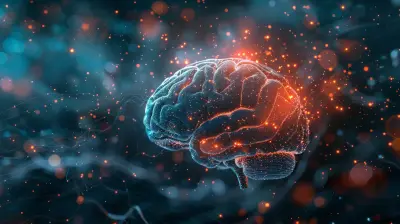Gestalt Psychology: Understanding Perception in Wholes
23 July 2025
Ever looked at a cloud and thought, “Hey, that looks like a dragon eating spaghetti?” Or stared at one of those optical illusions that flips between a duck and a rabbit based on how you look at it? If so, congratulations—your brain is doing something totally cool called Gestalt perception.
Welcome to the fascinating world of Gestalt Psychology, where things aren't always quite what they seem. This isn’t just psychology for the nerdy few—it’s something we all experience daily, whether we're assembling furniture, watching movies, or judging a pizza based on its toppings (yes, that counts). So, let’s break it down together—without the jargon overload.
What Is Gestalt Psychology Anyway?
Let’s rewind to the early 20th century—Vienna coffee shops, intellectual debates, and a few curious psychologists puzzle over perception. Among them were Max Wertheimer, Wolfgang Köhler, and Kurt Koffka. These pioneers weren’t buying into the trending psychological idea at the time, which was all about analyzing the mind by breaking it down into tiny pieces.Nope. These guys had a different vibe. They believed that we perceive things as a whole rather than just a sum of parts. They coined the term “Gestalt,” a German word meaning “shape” or “form,” to describe the idea that our minds are wired to see patterns, structures, and unified forms—automatically!
In simpler terms: Your brain is a big-picture thinker. Instead of zooming in on every pixel, it steps back and says, “Ah yes, art!”
Why Should You Care?
I know, I know—this sounds super academic. But hear me out.Understanding Gestalt Psychology can seriously upgrade how you see the world. From design to decision-making, relationships, and how you interpret your surroundings, this concept is a game-changer. It's like getting a cheat code for how your brain processes reality.
Ever wonder how logos like FedEx or the WWF panda are so memorable? Or why traffic signs are shaped the way they are? Or why you can read a scrambled sentence like “Thsi is waht hpapens wehn lteters are mxied up”? Gestalt principles are at play, my friend.
The Key Principles of Gestalt Psychology (Your Brain’s Toolkit)
Let’s dive into the juicy stuff—those powerful principles that guide perception. Don't worry, I’ll keep it easy-peasy.1. The Law of Prägnanz (a.k.a. Good Figure)
Sounds fancy, right? But it's simple. This law says we naturally lean toward simplicity and order. The brain’s motto here is: “Let’s clean this up.”So, when you see an image that’s a bit messy or abstract, your brain tidies it up automatically. It finds the most straightforward, stable shape possible—even if the image itself is incomplete. Super efficient.
2. Similarity
Birds of a feather flock together, and our brains agree. We tend to group similar things—same color, shape, size, or texture. When dots are the same color in a pattern, we see them as belonging together—even if they don't.It’s kind of like spotting your bestie in a crowd because they’re wearing your fave matching hoodie. Familiarity rules.
3. Proximity
Things that are close together? Our brain assumes they belong together.Think of musicians in an orchestra. Everyone’s playing different instruments, but put them closely on stage, and boom—they’re a unit. The same happens when you see items placed near each other; your brain connects the dots.
4. Continuity
Your mind doesn't like abrupt changes. It prefers smooth, continuous lines and paths. This principle is why you can follow a subway map and understand where the lines go—even when they twist and turn.In real life? It’s why your eye naturally follows the curve of a winding road, making sense of your path despite the chaos.
5. Closure
This one’s a mind-bender. You see a circle with a tiny piece missing—and your brain still registers it as a full circle, right?That’s closure. Your brain fills in the gaps and finishes the picture. Helpful? Hugely. Without it, we’d get lost in incomplete data. With it, we see the whole story.
6. Figure and Ground
Remember that good ol’ duck-rabbit illusion? That’s figure and ground doing their thing.This principle is all about focus. Your brain separates what you’re focusing on (the figure) from the background (the ground)—and sometimes, it switches between the two. Designers love using this trick. Ever notice hidden messages in logos (like the arrow in FedEx)? Now you know why.
Real-Life Gestalt: Where You’ve Already Seen It
You don’t need a psych degree to use Gestalt principles. You're already applying them in real-time—probably without knowing it.- Design & UX: Websites and apps use Gestalt to make interfaces intuitive. When buttons are grouped together, you assume they’re connected—and guess what? That’s intentional. It’s Proximity and Similarity working behind the scenes.
- Art & Photography: Artists use figure-ground contrast to draw attention. Ever seen a profile made from negative space? That’s closure and figure-ground showing off.
- Logos: Ever wonder why logos are so sticky in your mind? Gestalt. Take the Adidas stripes (Continuity), McDonald’s “M” (Closure), or the Olympics rings (Similarity and Proximity)—they all work because of clever perception tricks.
- Relationships (Yes, Really!): Ever jumped to conclusions because you filled in the blanks with assumptions? That’s your mind applying closure to social cues. Helpful? Sometimes. Hazardous? Definitely, when you assume too much.
Gestalt vs. The Whole “Parts” Thing
“But wait,” you say. “Isn’t everything made of parts?”It is—but Gestalt says the whole is more than the sum of its parts. Like baking a cake. Sure, you can list the ingredients: eggs, flour, sugar. But the final product? A delicious cake. The magic isn’t in the ingredients—it’s in how they come together.
So rather than studying the egg alone, Gestalt psychologists want to know how all the pieces mix to create the experience of “cake.” Or in brain-terms, perception.
Why Does This Matter Today?
In our fast-paced digital world, understanding perception is becoming a critical skill.- Marketing: Businesses use Gestalt to craft irresistible visuals.
- Education: Teachers design materials that group related info, helping students absorb better.
- Technology: Developers use perception patterns to create seamless, intuitive interfaces.
- Personal Life: Even conversations benefit. Understanding how others perceive things can make you more empathetic—and frankly, a better communicator.
Translation? Gestalt isn’t just academic noise—it’s practically useful in everyday life.
So…Is Our Brain Just Lazy?
Not lazy—efficient! Gestalt Psychology proves that our brains are designed for survival and speed. We’re pattern recognition pros! Recognizing danger, navigating complex environments, even just reading this blog post—all require quick judgment and holistic thinking. Ain’t nobody got time to process every pixel individually!Our minds take shortcuts, and most of the time, they work like a charm. When they don’t? Well—that’s where illusions, miscommunications, and even bias sneak in. But hey, at least now you’ll know what’s going on.
A Quick Recap (Because We’re All Busy)
Let’s sum this up, shall we?- Gestalt Psychology is all about looking at the whole picture.
- Your brain is wired to simplify, group, and interpret things based on patterns.
- The key principles—like proximity, similarity, continuity, and closure—help us make sense of the chaos.
- These same principles influence everything from traffic signs to Tinder profile pics (don’t act like you’ve never judged someone by their aesthetic).
- Ultimately, Gestalt shows us one thing clearly: The way we see the world is shaped not just by what’s there, but how our minds put it all together.
Final Thoughts: You, Me, and Perception
Perception isn’t just about what hits your eyeballs—it’s about how your brain interprets it all. Gestalt Psychology gives us a magical lens on that process, revealing how we find meaning in the abstract.So next time you’re zoning out and spotting giraffes in your ceiling tiles, just smile and say, “That’s Gestalt, baby.”
Perception doesn’t just happen—it’s designed, shaped, and powered by one of the most fascinating engines around: your mind.
all images in this post were generated using AI tools
Category:
Psychological TheoriesAuthor:

Nina Reilly
Discussion
rate this article
1 comments
Journey Wolf
This article beautifully highlights the essence of Gestalt Psychology and its impact on our perception. Understanding how we naturally organize our experiences into wholes is truly enlightening. Thank you for shedding light on this fascinating topic—it's a wonderful reminder of the complexity of our minds!
July 31, 2025 at 4:10 PM

Nina Reilly
Thank you for your thoughtful comment! I'm glad you found the article enlightening and appreciate your insights on the complexity of our perception.


